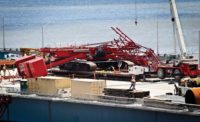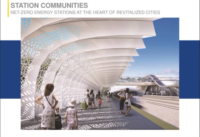
When the Utah Dept. of Transportation launched, in 2000, its $1.5-billion project to widen Interstate 15 through Salt Lake City, the agency opted for a delivery method called design-build, which was relatively rare at the time.
The UDOT chief then, Thomas Warne, predicted design-build would change "how we do business in the agency. … Contractors are doing more innovative things, and we're accepting of it."
That prediction holds true today in ever-increasing ways. For example, UDOT now uses accelerated bridge construction methods, construction management-general contracting and, of course, design-build on its current projects. Considering the scarcity of federal funding, this development is striking because the agency is completing its entire construction schedule for two freeway projects without relying upon a single federal dollar.
"Both of these projects are 100% state-funded," says John Njord, Warne's successor since 2002. "If we had waited for federal funds, it would have taken generations to build these projects. We have a population that will double in the next 40 years."
Already considered a pioneer among DOTs for embracing both alternative project delivery and accelerated bridge construction, UDOT seeks to achieve its goal of building 25 miles of new freeway in less than three years. "We decided that whether a project will merely last a short amount of time is not enough," Njord says. "We wanted the public to be wowed."
To do so, UDOT launched an aggressive outreach campaign that included a mock trailer for a fake movie, "The End Is Near." Shown in select theaters through last month, the trailer touted the pending completion of the 22-mile first phase of I-15 CORE, a 43-mile planned expansion of I-15 between Utah and Salt Lake counties. But UDOT project directors say they are just as wowed by what contractors were able to accomplish when given the flexibility to do so.
In 2010, gearing up for the project, UDOT discovered that "we had 43 miles of needs, or an estimated $6 billion worth of work, and a $1.75-billion budget," says Todd Jensen, project director. "But the contracting community came forward and blew us away with what they were able to propose. We thought we could deliver about 14 miles. We ended up with 24 miles."
The contract allowed for one lane of traffic to be shut down, but the design-build team—led by Fluor Corp. and including Ames Construction, Ralph L. Wadsworth Construction, Wadsworth Bros. and designer HDR—did so only about 10% of the time, Jensen says. "They widened the existing area to create work space and split two lanes around the work space on either side," he says.
To complicate matters, UDOT was still procuring rights of way (ROW) when construction began, Jensen adds. "We went through the lists of procurements and prioritized long-lead items," he says. "We gave the team a prioritized list according to when we could deliver the rest of the parcels. If they wanted to reprioritize something, we would respond."
Approximately 300 parcels were acquired, well below the preliminary estimate of 600. "We did not have a full understanding of ROW needs because, with design-build, you go in only with a preliminary design and start purchasing ROW off that," Jensen says. "When the design-build team gets onboard, they may make changes. You have to be nimble."
Significant utility relocations, settlement issues with old lake beds and a seismic zone also presented challenges. Out of 63 new bridges, the team moved six using accelerated bridge construction techniques, including self-propelled modular transporters to move into place a 354-ft-long overpass in just five hours (ENR 4/11/11 p. 29).
The project is on track to wrap up in December—almost two years ahead of UDOT's original expectations, Jensen adds. "At 35 months, we think this will be the fastest-performed project of its size."
During the same two years, a construction manager-general contractor (CMGC) team, led by Granite Construction, Kiewit Corp. and W.W. Clyde & Co., is completing the other major component of UDOT's transportation building blitz: the first 15 miles of a new freeway on the valley's west side. The $1-billion Mountain View Corridor comprises not only construction but methodical planning for future expansion as the current four-lane, 15-mile freeway someday will become an eight-lane, 35-mile freeway, says Teri Newell, UDOT project director.
After researching what other states have done in a similar situation, "we decided to build the outer lanes first, then the interchanges later," Newell says. "Right now, we're building ramps but not interchanges. As the whole area continues to grow, we will implement those interchanges as needed."
Challenges included shifting two major cross-country transmission lines, which are "up to a mile and a half along [so far], with alignments of new planned lines," Newell adds. "At this point, we have about $50 million dollars' worth of relocating utility lines. Ten million dollars' worth of the work is in our current construction project. The rest is in areas anticipated for future years of construction."
"The contractor sat with us during design," Newell notes. "They came up with $10 million in savings on the utilities, with ways to keep some lines in place and move others later. Having a contractor talk about weights of equipment moving across the lines gave us big credibility with the natural-gas guys."
As it nears an on-time completion, the project has about $30 million to invest in future projects, she adds. "We have funds for two more miles of the project," Newell says. "Right now, our program is $730 million, with another $180 million to come. We will see what happens after that."






